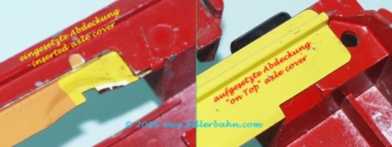|
Axle covers at the locos |
|
|
|
As all the world knows, there were 2
types of cover (or none) overhead the axles of the locos. |
|
|
|
The 1st version - until 1966 - was
inserted into the frame (to be seen in the middle of the picture) and
kept in position by means of 4 small fish plates - left side of the
picture. 2nd version was simply placed on top of the frame underneath
the hood. |
The reason why new covers had to be used was the new silver
Bühler engine, which had a littler larger diameter than the old brass
engine. There are some transitional versions - new silver motor with old
frame and old axle cover (1966 until latest 1969) |
 |
 |
|
|
|
Therefore 2 angled sections had to be made (right side of
the picture) at the front section of the frame - the old covers couldn't
be fixed anymore at this part of the frame. |
|
|
|
The non-visible inner side of the covers
are known to show various colors and lithos - initially blank or red.
After the production of the 1500E, 1013 E and the corresponding tenders
had ceased (1962), left-over tin plates were used to produce these
covers - showing various colors. So these lithographed covers indicate
the year of production between 1962 and 1966 (possibly 1969). |
|
The later version is known to show Yellow, Red, dark Green or Black on
the non visible side. The visible side was mainly red - for locos with
black frame / engine the visible cover side could be black as well. Subsequently all locos
with the flat switch must have the inserted tin cover - all locos with the
cog-wheeled switch must have the longer later version. |
 |
|
As of 1973 Biller even left out the covers
for the axles and motors (in the cabin) |
| generated: FEB-12-2006 |
last update: Christmas 2007 |